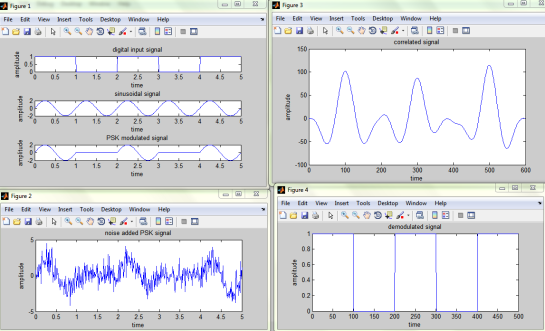
CODE:
clc;
clear all;
close all;
x=input(‘Enter the input digital sequence’);
N=length(x);
t=0.01:0.01:N;
c=2*sin(2*pi*t);
for i=1:1:N
m((i-1)*100+1:i*100)=x(i);
end
y=c.*m;
subplot(3,1,1);
plot(t,m);
xlabel(‘time’);
ylabel(‘amplitude’);
title(‘digital input signal’);
subplot(3,1,2);
plot(t,c);
xlabel(‘time’);
ylabel(‘amplitude’);
title(‘sinusoidal signal’);
subplot(3,1,3);
plot(t,y);
xlabel(‘time’);
ylabel(‘amplitude’);
title(‘PSK modulated signal’);
r=randn(1,length(y));
k=y+r;
figure;
plot(t,k);
xlabel(‘time’);
ylabel(‘amplitude’);
title(‘noise added PSK signal’);
t1=0:0.01:.99;
r1=sin(2*pi*t1);
r2=fliplr(r1);
l=length(k)+length(r2)-1;
d1=fft(k,l);
d2=fft(r2,l);
d=d1.*d2;
p=ifft(d,l);
figure;
plot(p);
xlabel(‘time’);
ylabel(‘amplitude’);
title(‘correlated signal’);
for j=1:length(x)
q(j)=p(100*j);
if q(j)>15
m1(j)=1;
else
m1(j)=0;
end
end
for i=1:1:N
s((i-1)*100+1:i*100)=m1(i);
end
figure;
plot(s);
xlabel(‘time’);
ylabel(‘amplitude’);
title(‘demodulated signal’);
Amplitude-shift keying (ASK) is a form of modulation that represents digital data as variations in the amplitude of a carrier wave.
Any din scheme uses a finite number of distinct signals to represent digital data. ASK uses a finite number of amplitudes, each assigned a unique pattern of binary digits. Usually, each amplitude encodes an equal number of bits. Each pattern of bits forms the symbol that is represented by the particular amplitude. The demodulator, which is designed specifically for the symbol-set used by the modulator, determines the amplitude of the received signal and maps it back to the symbol it represents, thus recovering the original data. Frequency and phase of the carrier are kept constant.
Like AM, ASK is also linear and sensitive to atmospheric noise, distortions, propagation conditions on different routes in PSTN, etc. Both ASK modulation and demodulation processes are relatively inexpensive. The ASK technique is also commonly used to transmit digital data over optical fiber. For LED transmitters, binary 1 is represented by a short pulse of light and binary 0 by the absence of light. Laser transmitters normally have a fixed “bias” current that causes the device to emit a low light level. This low level represents binary 0, while a higher-amplitude lightwave represents binary 1.
The simplest and most common form of ASK operates as a switch, using the presence of a carrier wave to indicate a binary one and its absence to indicate a binary zero. This type of modulation is called on-off keying, and is used at radio frequencies to transmit Morse code (referred to as continuous wave operation),
More sophisticated encoding schemes have been developed which represent data in groups using additional amplitude levels. For instance, a four-level encoding scheme can represent two bits with each shift in amplitude; an eight-level scheme can represent three bits; and so on. These forms of amplitude-shift keying require a high signal-to-noise ratio for their recovery, as by their nature much of the signal is transmitted at reduced power.
REFERENCE:
Hi, I�ve been a lurker around your blog for a few months. I love this article and your entire site! Looking forward to reading more!
Good day I am so thrilled I found your weblog, I really found you by mistake, while I was searching on Aol for something else, Anyways I am here now and would just like to say thanks for a remarkable post and a all round enjoyable blog (I also love the theme/design), I don’t have time to read it all at the minute but I have book-marked it and also added in your RSS feeds, so when I have time I will be back to read much more, Please do keep up the excellent work.
Very interesting info!Perfect just what I was searching for!